Aviation Safety Issues and Maintenance Models
VerifiedAdded on 2020/10/04
|7
|1693
|389
AI Summary
The provided document is an analysis of aviation safety issues and maintenance models. It highlights the significance of human factors, including fatigue and stress, which can lead to mismanagement and accidents. The document also emphasizes the importance of safety management systems (SMS) in managing safety measurements and achieving tolerable safety standards. The author recommends employing more personnel for maintenance and implementing proper procedures to ensure safe flights.
Contribute Materials
Your contribution can guide someone’s learning journey. Share your
documents today.
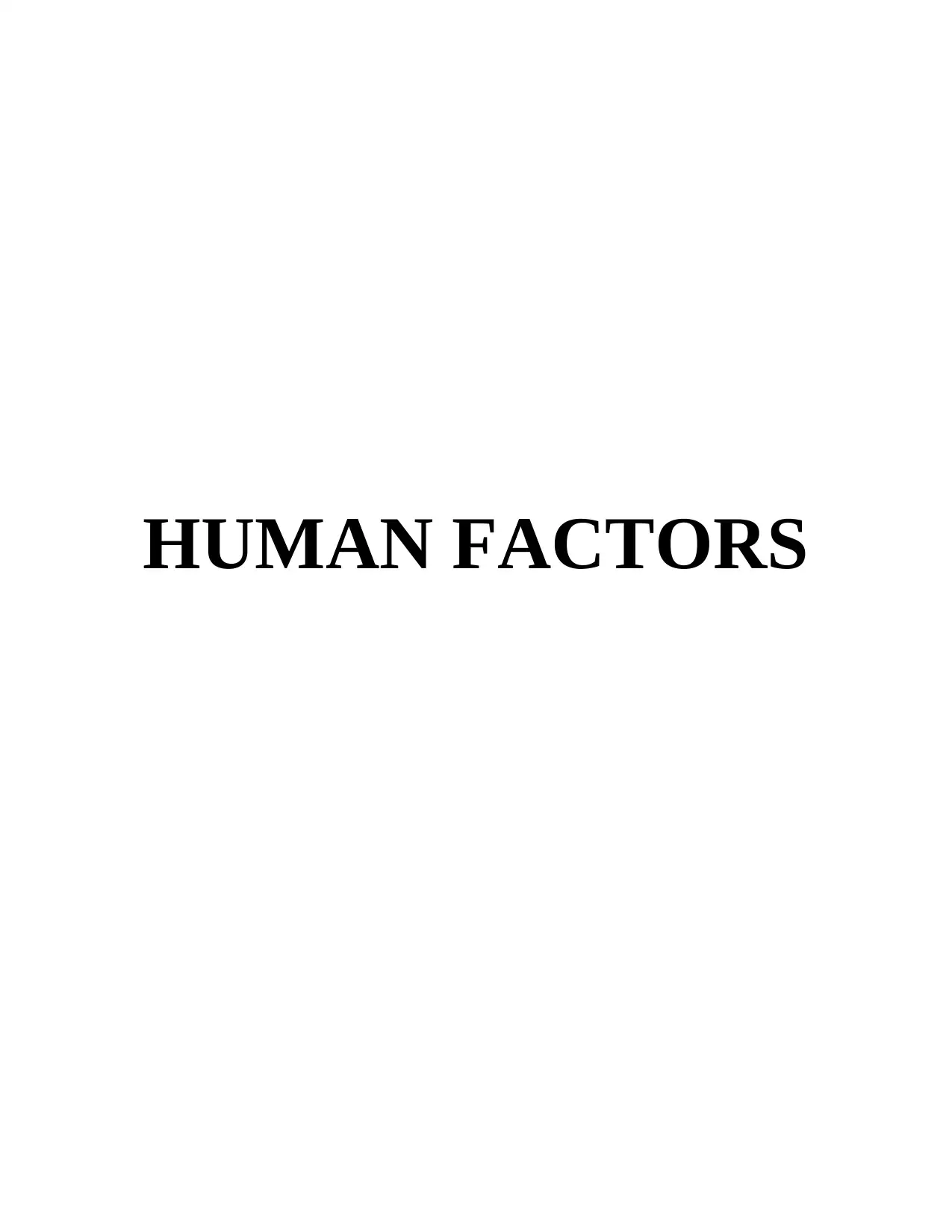
HUMAN FACTORS
Secure Best Marks with AI Grader
Need help grading? Try our AI Grader for instant feedback on your assignments.
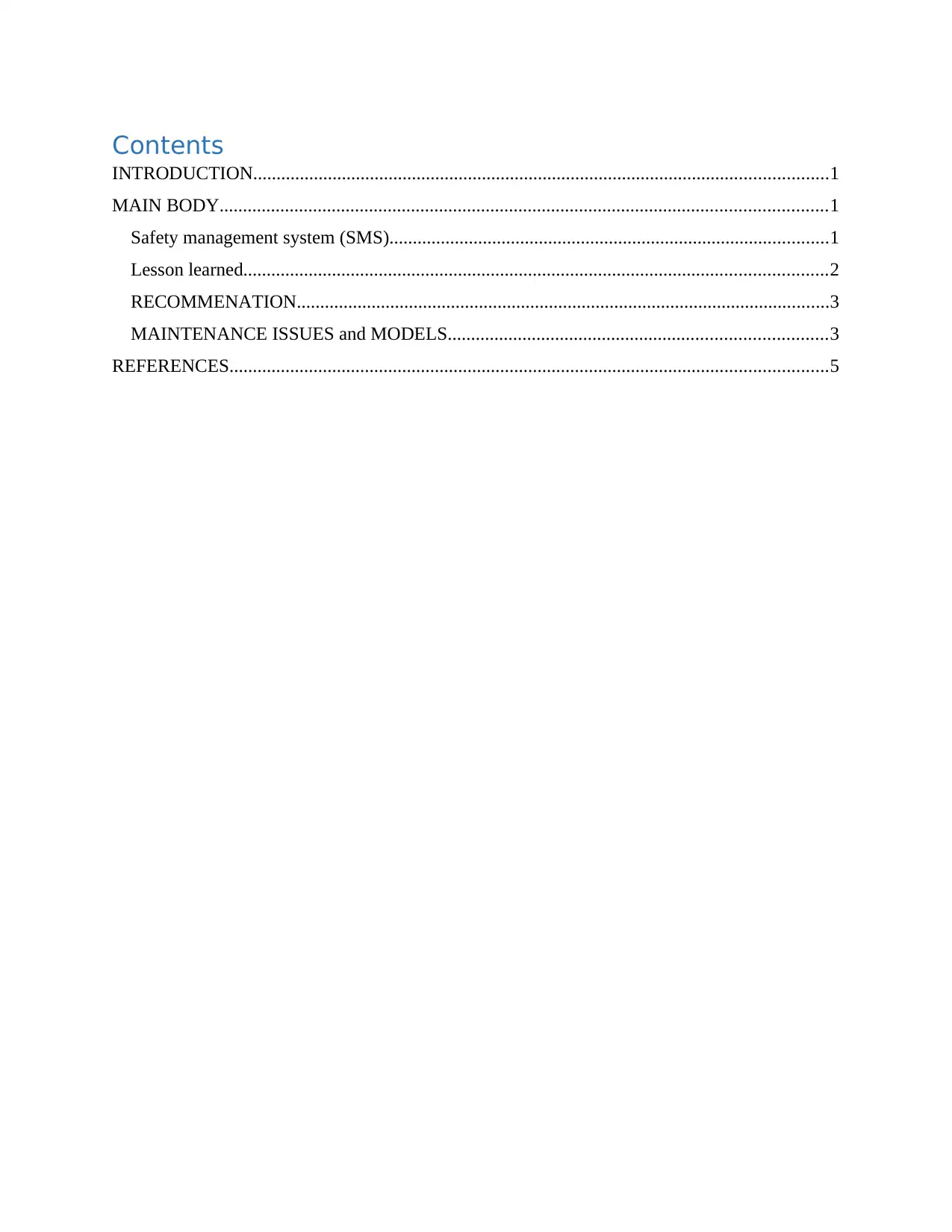
Contents
INTRODUCTION...........................................................................................................................1
MAIN BODY..................................................................................................................................1
Safety management system (SMS)..............................................................................................1
Lesson learned.............................................................................................................................2
RECOMMENATION..................................................................................................................3
MAINTENANCE ISSUES and MODELS.................................................................................3
REFERENCES................................................................................................................................5
INTRODUCTION...........................................................................................................................1
MAIN BODY..................................................................................................................................1
Safety management system (SMS)..............................................................................................1
Lesson learned.............................................................................................................................2
RECOMMENATION..................................................................................................................3
MAINTENANCE ISSUES and MODELS.................................................................................3
REFERENCES................................................................................................................................5
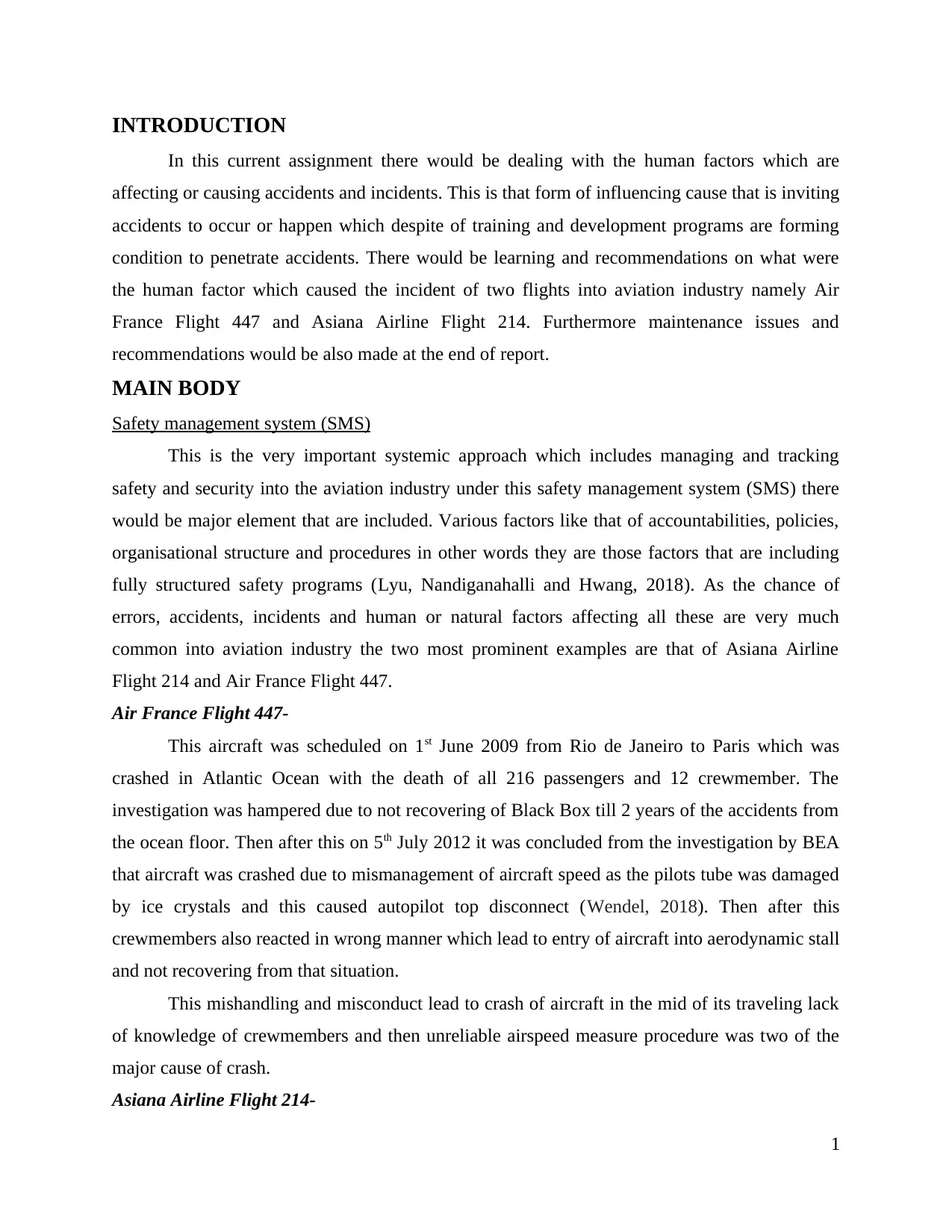
INTRODUCTION
In this current assignment there would be dealing with the human factors which are
affecting or causing accidents and incidents. This is that form of influencing cause that is inviting
accidents to occur or happen which despite of training and development programs are forming
condition to penetrate accidents. There would be learning and recommendations on what were
the human factor which caused the incident of two flights into aviation industry namely Air
France Flight 447 and Asiana Airline Flight 214. Furthermore maintenance issues and
recommendations would be also made at the end of report.
MAIN BODY
Safety management system (SMS)
This is the very important systemic approach which includes managing and tracking
safety and security into the aviation industry under this safety management system (SMS) there
would be major element that are included. Various factors like that of accountabilities, policies,
organisational structure and procedures in other words they are those factors that are including
fully structured safety programs (Lyu, Nandiganahalli and Hwang, 2018). As the chance of
errors, accidents, incidents and human or natural factors affecting all these are very much
common into aviation industry the two most prominent examples are that of Asiana Airline
Flight 214 and Air France Flight 447.
Air France Flight 447-
This aircraft was scheduled on 1st June 2009 from Rio de Janeiro to Paris which was
crashed in Atlantic Ocean with the death of all 216 passengers and 12 crewmember. The
investigation was hampered due to not recovering of Black Box till 2 years of the accidents from
the ocean floor. Then after this on 5th July 2012 it was concluded from the investigation by BEA
that aircraft was crashed due to mismanagement of aircraft speed as the pilots tube was damaged
by ice crystals and this caused autopilot top disconnect (Wendel, 2018). Then after this
crewmembers also reacted in wrong manner which lead to entry of aircraft into aerodynamic stall
and not recovering from that situation.
This mishandling and misconduct lead to crash of aircraft in the mid of its traveling lack
of knowledge of crewmembers and then unreliable airspeed measure procedure was two of the
major cause of crash.
Asiana Airline Flight 214-
1
In this current assignment there would be dealing with the human factors which are
affecting or causing accidents and incidents. This is that form of influencing cause that is inviting
accidents to occur or happen which despite of training and development programs are forming
condition to penetrate accidents. There would be learning and recommendations on what were
the human factor which caused the incident of two flights into aviation industry namely Air
France Flight 447 and Asiana Airline Flight 214. Furthermore maintenance issues and
recommendations would be also made at the end of report.
MAIN BODY
Safety management system (SMS)
This is the very important systemic approach which includes managing and tracking
safety and security into the aviation industry under this safety management system (SMS) there
would be major element that are included. Various factors like that of accountabilities, policies,
organisational structure and procedures in other words they are those factors that are including
fully structured safety programs (Lyu, Nandiganahalli and Hwang, 2018). As the chance of
errors, accidents, incidents and human or natural factors affecting all these are very much
common into aviation industry the two most prominent examples are that of Asiana Airline
Flight 214 and Air France Flight 447.
Air France Flight 447-
This aircraft was scheduled on 1st June 2009 from Rio de Janeiro to Paris which was
crashed in Atlantic Ocean with the death of all 216 passengers and 12 crewmember. The
investigation was hampered due to not recovering of Black Box till 2 years of the accidents from
the ocean floor. Then after this on 5th July 2012 it was concluded from the investigation by BEA
that aircraft was crashed due to mismanagement of aircraft speed as the pilots tube was damaged
by ice crystals and this caused autopilot top disconnect (Wendel, 2018). Then after this
crewmembers also reacted in wrong manner which lead to entry of aircraft into aerodynamic stall
and not recovering from that situation.
This mishandling and misconduct lead to crash of aircraft in the mid of its traveling lack
of knowledge of crewmembers and then unreliable airspeed measure procedure was two of the
major cause of crash.
Asiana Airline Flight 214-
1
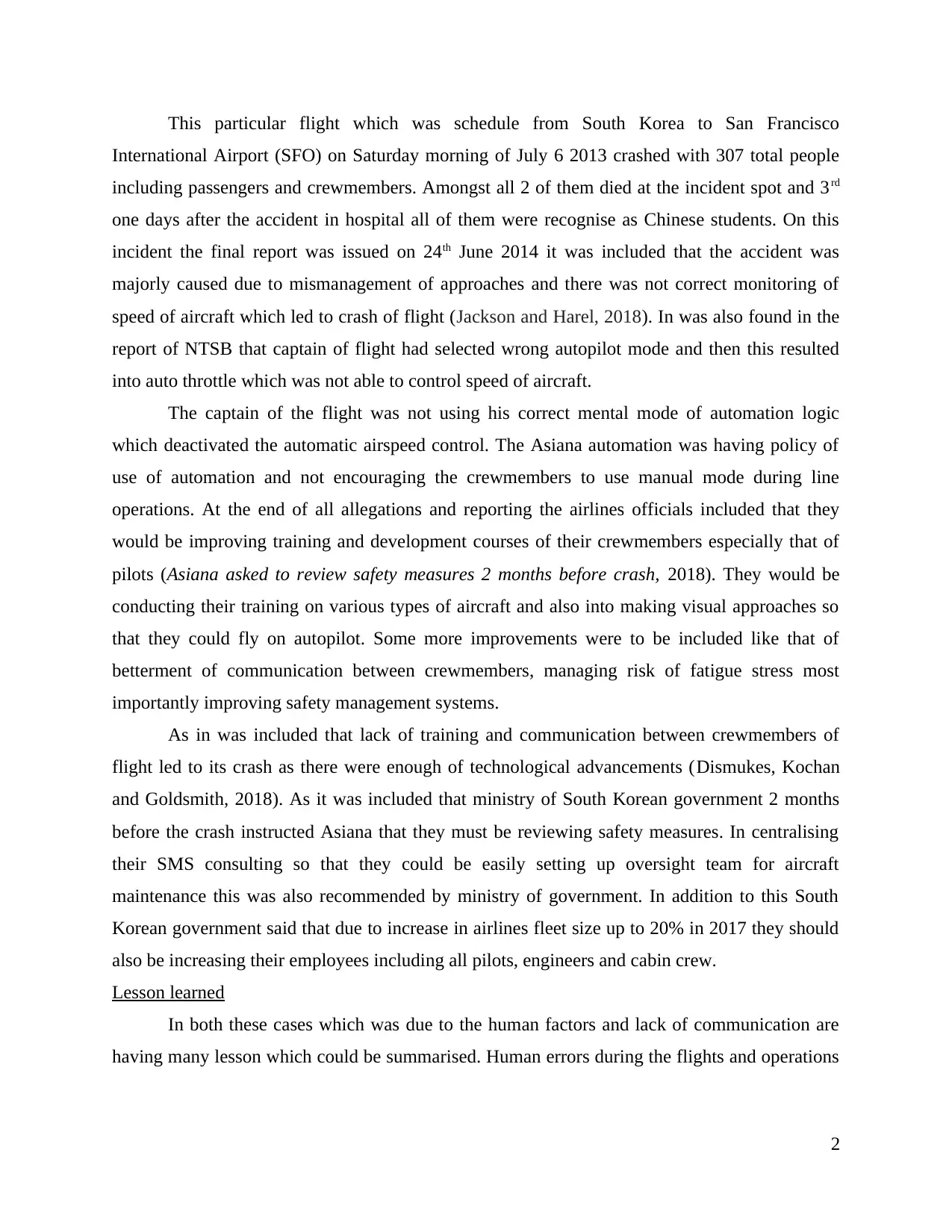
This particular flight which was schedule from South Korea to San Francisco
International Airport (SFO) on Saturday morning of July 6 2013 crashed with 307 total people
including passengers and crewmembers. Amongst all 2 of them died at the incident spot and 3rd
one days after the accident in hospital all of them were recognise as Chinese students. On this
incident the final report was issued on 24th June 2014 it was included that the accident was
majorly caused due to mismanagement of approaches and there was not correct monitoring of
speed of aircraft which led to crash of flight (Jackson and Harel, 2018). In was also found in the
report of NTSB that captain of flight had selected wrong autopilot mode and then this resulted
into auto throttle which was not able to control speed of aircraft.
The captain of the flight was not using his correct mental mode of automation logic
which deactivated the automatic airspeed control. The Asiana automation was having policy of
use of automation and not encouraging the crewmembers to use manual mode during line
operations. At the end of all allegations and reporting the airlines officials included that they
would be improving training and development courses of their crewmembers especially that of
pilots (Asiana asked to review safety measures 2 months before crash, 2018). They would be
conducting their training on various types of aircraft and also into making visual approaches so
that they could fly on autopilot. Some more improvements were to be included like that of
betterment of communication between crewmembers, managing risk of fatigue stress most
importantly improving safety management systems.
As in was included that lack of training and communication between crewmembers of
flight led to its crash as there were enough of technological advancements (Dismukes, Kochan
and Goldsmith, 2018). As it was included that ministry of South Korean government 2 months
before the crash instructed Asiana that they must be reviewing safety measures. In centralising
their SMS consulting so that they could be easily setting up oversight team for aircraft
maintenance this was also recommended by ministry of government. In addition to this South
Korean government said that due to increase in airlines fleet size up to 20% in 2017 they should
also be increasing their employees including all pilots, engineers and cabin crew.
Lesson learned
In both these cases which was due to the human factors and lack of communication are
having many lesson which could be summarised. Human errors during the flights and operations
2
International Airport (SFO) on Saturday morning of July 6 2013 crashed with 307 total people
including passengers and crewmembers. Amongst all 2 of them died at the incident spot and 3rd
one days after the accident in hospital all of them were recognise as Chinese students. On this
incident the final report was issued on 24th June 2014 it was included that the accident was
majorly caused due to mismanagement of approaches and there was not correct monitoring of
speed of aircraft which led to crash of flight (Jackson and Harel, 2018). In was also found in the
report of NTSB that captain of flight had selected wrong autopilot mode and then this resulted
into auto throttle which was not able to control speed of aircraft.
The captain of the flight was not using his correct mental mode of automation logic
which deactivated the automatic airspeed control. The Asiana automation was having policy of
use of automation and not encouraging the crewmembers to use manual mode during line
operations. At the end of all allegations and reporting the airlines officials included that they
would be improving training and development courses of their crewmembers especially that of
pilots (Asiana asked to review safety measures 2 months before crash, 2018). They would be
conducting their training on various types of aircraft and also into making visual approaches so
that they could fly on autopilot. Some more improvements were to be included like that of
betterment of communication between crewmembers, managing risk of fatigue stress most
importantly improving safety management systems.
As in was included that lack of training and communication between crewmembers of
flight led to its crash as there were enough of technological advancements (Dismukes, Kochan
and Goldsmith, 2018). As it was included that ministry of South Korean government 2 months
before the crash instructed Asiana that they must be reviewing safety measures. In centralising
their SMS consulting so that they could be easily setting up oversight team for aircraft
maintenance this was also recommended by ministry of government. In addition to this South
Korean government said that due to increase in airlines fleet size up to 20% in 2017 they should
also be increasing their employees including all pilots, engineers and cabin crew.
Lesson learned
In both these cases which was due to the human factors and lack of communication are
having many lesson which could be summarised. Human errors during the flights and operations
2
Secure Best Marks with AI Grader
Need help grading? Try our AI Grader for instant feedback on your assignments.
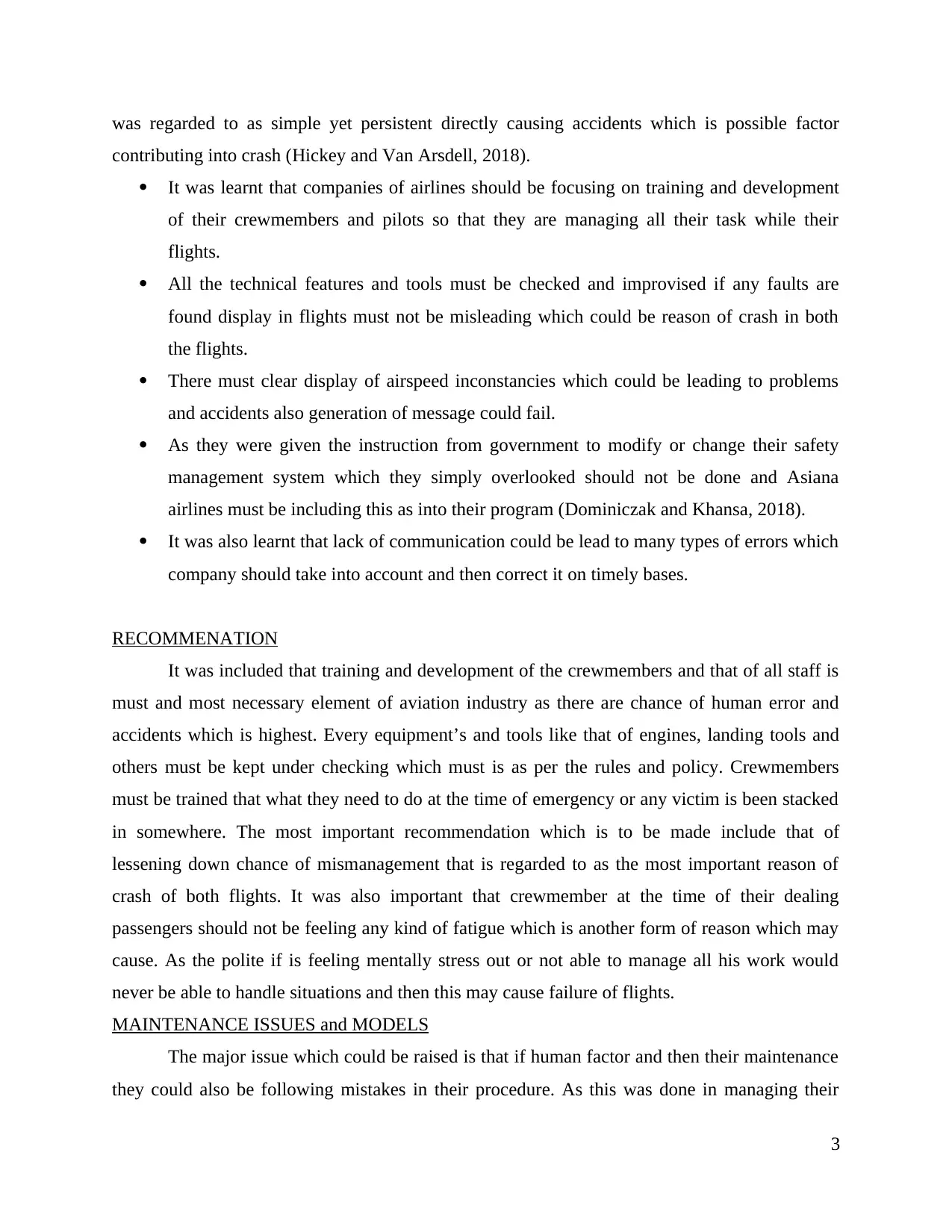
was regarded to as simple yet persistent directly causing accidents which is possible factor
contributing into crash (Hickey and Van Arsdell, 2018).
It was learnt that companies of airlines should be focusing on training and development
of their crewmembers and pilots so that they are managing all their task while their
flights.
All the technical features and tools must be checked and improvised if any faults are
found display in flights must not be misleading which could be reason of crash in both
the flights.
There must clear display of airspeed inconstancies which could be leading to problems
and accidents also generation of message could fail.
As they were given the instruction from government to modify or change their safety
management system which they simply overlooked should not be done and Asiana
airlines must be including this as into their program (Dominiczak and Khansa, 2018).
It was also learnt that lack of communication could be lead to many types of errors which
company should take into account and then correct it on timely bases.
RECOMMENATION
It was included that training and development of the crewmembers and that of all staff is
must and most necessary element of aviation industry as there are chance of human error and
accidents which is highest. Every equipment’s and tools like that of engines, landing tools and
others must be kept under checking which must is as per the rules and policy. Crewmembers
must be trained that what they need to do at the time of emergency or any victim is been stacked
in somewhere. The most important recommendation which is to be made include that of
lessening down chance of mismanagement that is regarded to as the most important reason of
crash of both flights. It was also important that crewmember at the time of their dealing
passengers should not be feeling any kind of fatigue which is another form of reason which may
cause. As the polite if is feeling mentally stress out or not able to manage all his work would
never be able to handle situations and then this may cause failure of flights.
MAINTENANCE ISSUES and MODELS
The major issue which could be raised is that if human factor and then their maintenance
they could also be following mistakes in their procedure. As this was done in managing their
3
contributing into crash (Hickey and Van Arsdell, 2018).
It was learnt that companies of airlines should be focusing on training and development
of their crewmembers and pilots so that they are managing all their task while their
flights.
All the technical features and tools must be checked and improvised if any faults are
found display in flights must not be misleading which could be reason of crash in both
the flights.
There must clear display of airspeed inconstancies which could be leading to problems
and accidents also generation of message could fail.
As they were given the instruction from government to modify or change their safety
management system which they simply overlooked should not be done and Asiana
airlines must be including this as into their program (Dominiczak and Khansa, 2018).
It was also learnt that lack of communication could be lead to many types of errors which
company should take into account and then correct it on timely bases.
RECOMMENATION
It was included that training and development of the crewmembers and that of all staff is
must and most necessary element of aviation industry as there are chance of human error and
accidents which is highest. Every equipment’s and tools like that of engines, landing tools and
others must be kept under checking which must is as per the rules and policy. Crewmembers
must be trained that what they need to do at the time of emergency or any victim is been stacked
in somewhere. The most important recommendation which is to be made include that of
lessening down chance of mismanagement that is regarded to as the most important reason of
crash of both flights. It was also important that crewmember at the time of their dealing
passengers should not be feeling any kind of fatigue which is another form of reason which may
cause. As the polite if is feeling mentally stress out or not able to manage all his work would
never be able to handle situations and then this may cause failure of flights.
MAINTENANCE ISSUES and MODELS
The major issue which could be raised is that if human factor and then their maintenance
they could also be following mistakes in their procedure. As this was done in managing their
3
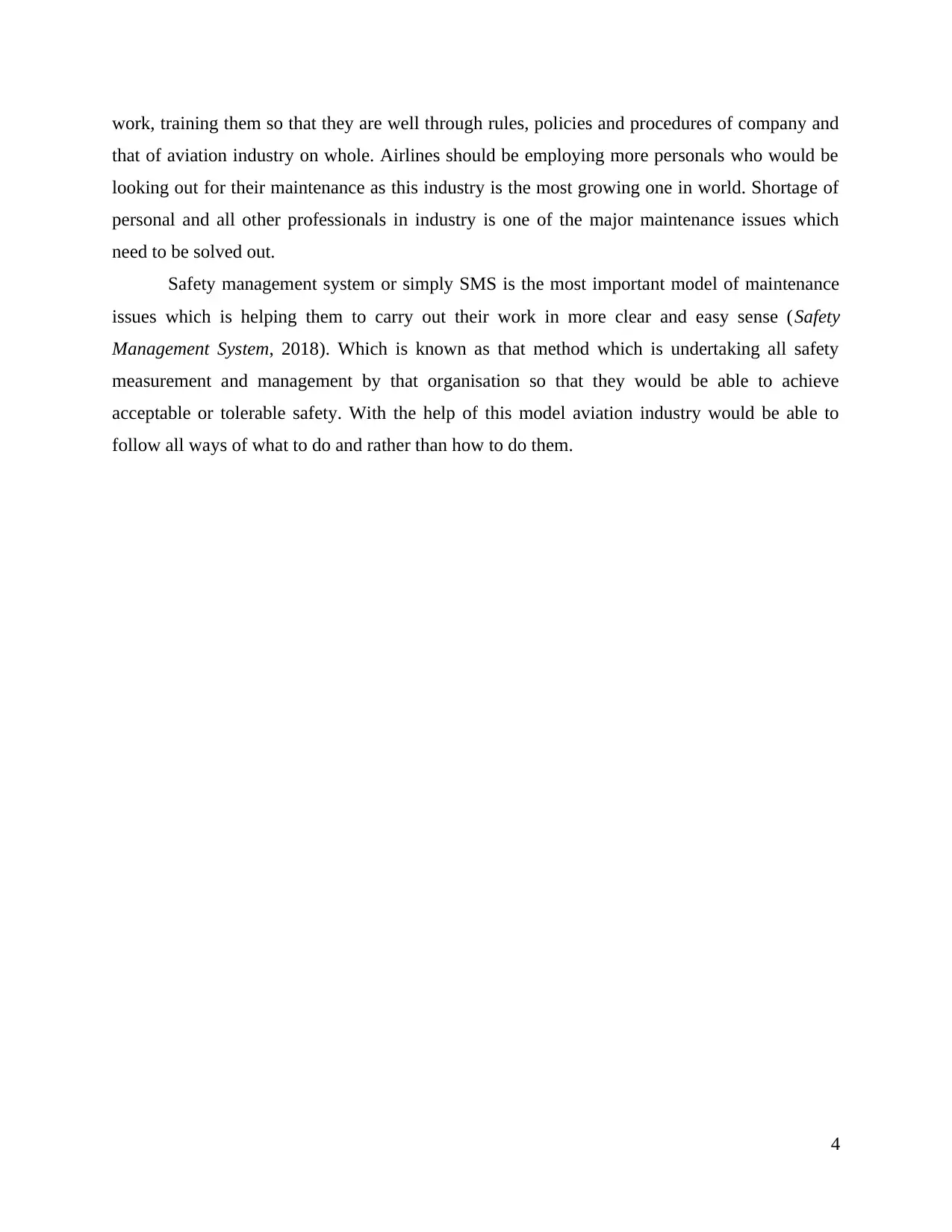
work, training them so that they are well through rules, policies and procedures of company and
that of aviation industry on whole. Airlines should be employing more personals who would be
looking out for their maintenance as this industry is the most growing one in world. Shortage of
personal and all other professionals in industry is one of the major maintenance issues which
need to be solved out.
Safety management system or simply SMS is the most important model of maintenance
issues which is helping them to carry out their work in more clear and easy sense (Safety
Management System, 2018). Which is known as that method which is undertaking all safety
measurement and management by that organisation so that they would be able to achieve
acceptable or tolerable safety. With the help of this model aviation industry would be able to
follow all ways of what to do and rather than how to do them.
4
that of aviation industry on whole. Airlines should be employing more personals who would be
looking out for their maintenance as this industry is the most growing one in world. Shortage of
personal and all other professionals in industry is one of the major maintenance issues which
need to be solved out.
Safety management system or simply SMS is the most important model of maintenance
issues which is helping them to carry out their work in more clear and easy sense (Safety
Management System, 2018). Which is known as that method which is undertaking all safety
measurement and management by that organisation so that they would be able to achieve
acceptable or tolerable safety. With the help of this model aviation industry would be able to
follow all ways of what to do and rather than how to do them.
4
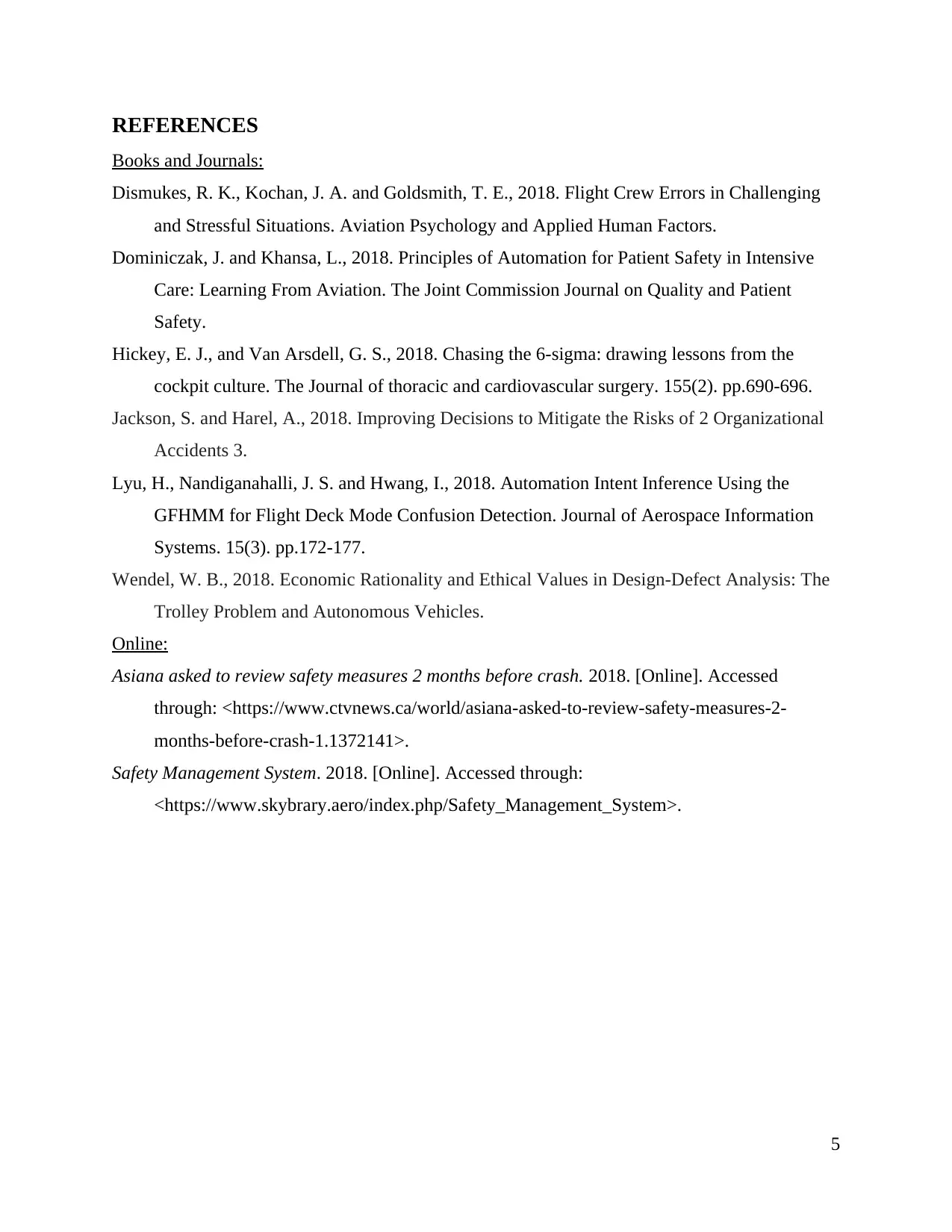
REFERENCES
Books and Journals:
Dismukes, R. K., Kochan, J. A. and Goldsmith, T. E., 2018. Flight Crew Errors in Challenging
and Stressful Situations. Aviation Psychology and Applied Human Factors.
Dominiczak, J. and Khansa, L., 2018. Principles of Automation for Patient Safety in Intensive
Care: Learning From Aviation. The Joint Commission Journal on Quality and Patient
Safety.
Hickey, E. J., and Van Arsdell, G. S., 2018. Chasing the 6-sigma: drawing lessons from the
cockpit culture. The Journal of thoracic and cardiovascular surgery. 155(2). pp.690-696.
Jackson, S. and Harel, A., 2018. Improving Decisions to Mitigate the Risks of 2 Organizational
Accidents 3.
Lyu, H., Nandiganahalli, J. S. and Hwang, I., 2018. Automation Intent Inference Using the
GFHMM for Flight Deck Mode Confusion Detection. Journal of Aerospace Information
Systems. 15(3). pp.172-177.
Wendel, W. B., 2018. Economic Rationality and Ethical Values in Design-Defect Analysis: The
Trolley Problem and Autonomous Vehicles.
Online:
Asiana asked to review safety measures 2 months before crash. 2018. [Online]. Accessed
through: <https://www.ctvnews.ca/world/asiana-asked-to-review-safety-measures-2-
months-before-crash-1.1372141>.
Safety Management System. 2018. [Online]. Accessed through:
<https://www.skybrary.aero/index.php/Safety_Management_System>.
5
Books and Journals:
Dismukes, R. K., Kochan, J. A. and Goldsmith, T. E., 2018. Flight Crew Errors in Challenging
and Stressful Situations. Aviation Psychology and Applied Human Factors.
Dominiczak, J. and Khansa, L., 2018. Principles of Automation for Patient Safety in Intensive
Care: Learning From Aviation. The Joint Commission Journal on Quality and Patient
Safety.
Hickey, E. J., and Van Arsdell, G. S., 2018. Chasing the 6-sigma: drawing lessons from the
cockpit culture. The Journal of thoracic and cardiovascular surgery. 155(2). pp.690-696.
Jackson, S. and Harel, A., 2018. Improving Decisions to Mitigate the Risks of 2 Organizational
Accidents 3.
Lyu, H., Nandiganahalli, J. S. and Hwang, I., 2018. Automation Intent Inference Using the
GFHMM for Flight Deck Mode Confusion Detection. Journal of Aerospace Information
Systems. 15(3). pp.172-177.
Wendel, W. B., 2018. Economic Rationality and Ethical Values in Design-Defect Analysis: The
Trolley Problem and Autonomous Vehicles.
Online:
Asiana asked to review safety measures 2 months before crash. 2018. [Online]. Accessed
through: <https://www.ctvnews.ca/world/asiana-asked-to-review-safety-measures-2-
months-before-crash-1.1372141>.
Safety Management System. 2018. [Online]. Accessed through:
<https://www.skybrary.aero/index.php/Safety_Management_System>.
5
1 out of 7
Related Documents
Your All-in-One AI-Powered Toolkit for Academic Success.
+13062052269
info@desklib.com
Available 24*7 on WhatsApp / Email
![[object Object]](/_next/static/media/star-bottom.7253800d.svg)
Unlock your academic potential
© 2024 | Zucol Services PVT LTD | All rights reserved.





